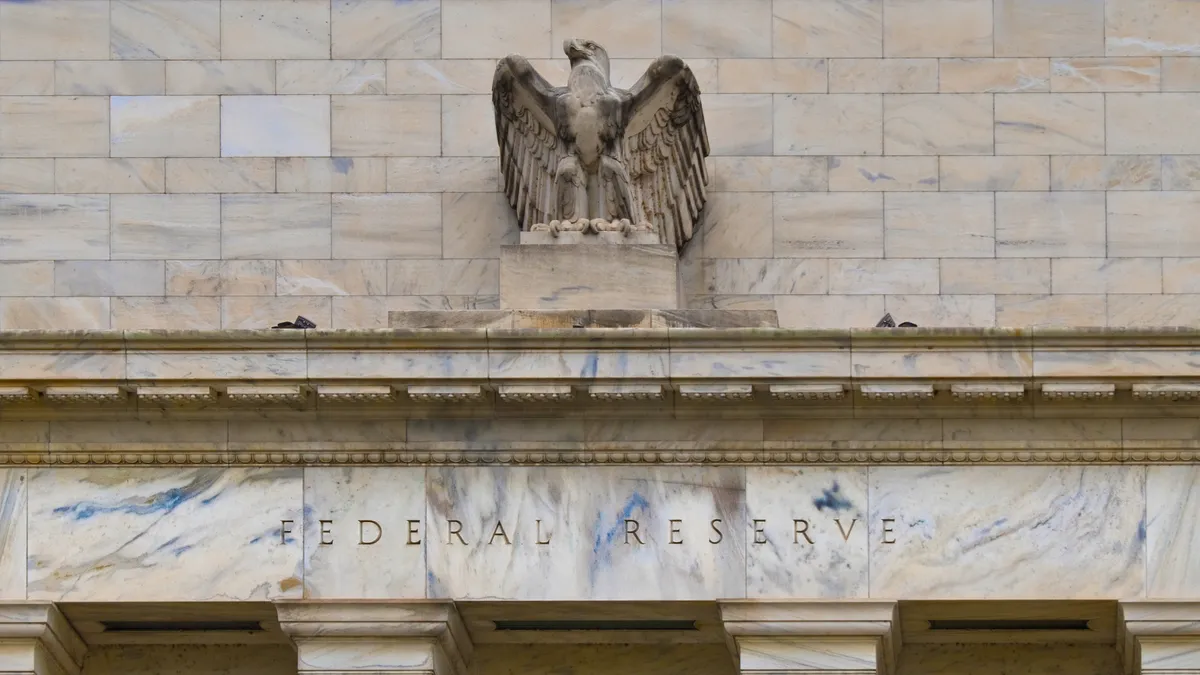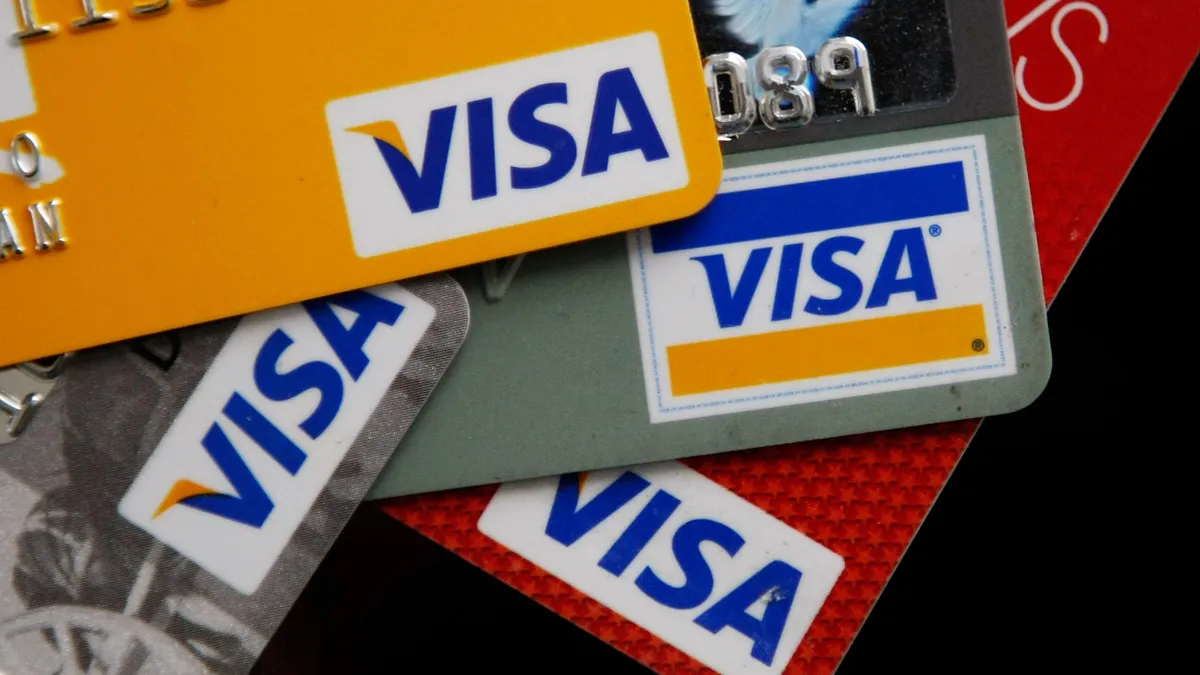Dive Brief:
- The Federal Reserve Board voted Wednesday in favor of a proposal that would cut a cap on the interchange fee that debit card issuers can charge merchants to process a transaction. The proposal would lower the base debit fee rate by about 30% to 14.4 cents from 21 cents, according to a proposal memo produced by the Fed’s staff last week.
- The proposed changes to Regulation II, under the 2010 Dodd-Frank Wall Street Reform and Consumer Protection Act, would also adjust the amounts that bank card issuers subject to the rule can charge to cover fraud costs and to counter fraud losses.
- “These data show that the costs incurred by covered issuers in connection with debit card transactions have changed significantly over time,” the staff memo said. “In particular, the transaction-processing costs on which the Board based the base component have nearly halved.”
Dive Insight:
With the move, the Fed also proposed to codify certain changes to the rule so that fees are updated every other year based on a review of industry data that is already required to take place every two years. The cap hasn’t been changed since it was set in 2011.
The changes were signaled last week when the Fed published the agenda for a meeting Wednesday at which it planned to take up a reassessment of the cap.
Currently, the cap is set at 21 cents plus 0.05% of the value of the debit transaction, in addition to a one-cent fraud-prevention adjustment. The fee cap applies to banks and financial institutions that issue debit cards and have $10 billion or more in deposits.
“These future updates to the interchange fee cap would be published without inviting public comment and would be published by March 31 of odd-numbered years, with the new amounts taking effect on July 1 and remaining in effect for two years,” the memo said.
As for the Fed’s proposal today, after it’s published in the Federal Register, there will be a 90-day comment period for feedback, the memo said. If the rule is ultimately adopted, it would take effect 60 days after the final rule is published in the Federal Register.
Fraud costs considered
The Fed also proposed reducing the amount card issuers can include in the fee for fraud losses, cutting that amount to .04% of the value of the debit transaction from .05%. By contrast, the board recommended increasing the amount issuers can charge for the cost of preventing fraud, raising that amount to 1.3 cents, from one cent.
Like the base rate, those fraud-related adjustments were based on Fed data gathered from card issuers in a review of 2021 debit card transactions released this month. Biennial reviews are required by the regulation. The memo noted that the current cap is based on transaction data from 2009. It’s not clear why the Fed opted against making adjustments to the cap earlier.
The fee cap applies to banks and other financial institutions that issue debit cards and have $10 billion or more in deposits. Under the rule, the cap is expected to be “reasonable and proportional to the costs incurred by the issuer with respect to the transaction.”
In making the changes, the Fed’s staff noted that “debit cards are the most popular form of non-cash payment in the United States,” citing its past research.
The Fed’s reconsideration comes just weeks after the U.S. Supreme Court said it would hear a complaint from North Dakota merchants who argued the Fed’s debit cap is too high. The merchants’ petition for review isn’t with respect to the merits of the 2021 case, but rather an appellate court’s affirmation last year that the merchants brought the case past a statute-of-limitations date.
Merchants not satisfied with fee change
Merchants have railed for years that interchange fees on debit and credit card transactions are too high. Their trade groups applauded the move by the Fed to lower the cap, but argued it didn’t go far enough.
“Banks have been charging more than five times their costs for debit card transactions and the Fed is finally saying that’s too much,” National Association of Convenience Stores General Counsel Doug Kantor said in a Merchant Payments Coalition press release. “This is a step in the right direction toward the real, competitive market that Congress wanted to see, but still leaves the fees too high. Merchants and the consumers who ultimately pay these fees have been overcharged for far too long, so we need to get this right.”
The Fed’s staff speculated in the memo about the potential impact of the changes, saying the lower fee cap “should” reduce costs for merchants and may also cut consumer costs. It could also spur merchants to accept debit cards in markets where they haven’t been as widely accepted, such as in the e-commerce arena.
The staff memo also acknowledged that the fee changes will undercut interchange revenue for card issuers covered by the rule, and speculated they might offset those losses by reducing their expenses, or changing terms and fees for consumers.
Banks are disappointed too
The American Bankers Association expressed disappointment with the changes and said it will oppose them. "This proposal has the potential to make checking accounts, debit cards and a range of financial products more expensive for American consumers, while delivering an unprecedented gift to big-box retailers that have shown no inclination to pass any savings along to customers," the trade group said in a statement.
Despite that risk to consumers, the Fed staff predicted competition among the banks would most likely temper any negative impact for consumers. “While some of these changes could make checking account and debit card programs less attractive to consumers, the growth in debit card popularity following the introduction of the current interchange fee cap in 2011 suggests that this effect is likely to be muted,” the memo said.
Analysts who follow the bank card issuers and card networks, including Visa and Mastercard, also weighed in on the expected impact. While the bank issuers will be hurt by the lower fees, the networks are “unlikely” to be significantly impacted and some fintech processors, including Square and Toast, are likely to benefit from lower costs, while larger processors, such as Fiserv and Fidelity National Information Services, benefit to a lesser degree, said an investment note from the financial firm Robert W. Baird.
Fed Governor Michelle Bowman was the lone Fed member who voted against the proposal, cautioning that consumers would be adversely affected. “While the proposal suggests that it could result in benefits to consumers, I am concerned that the costs for consumers—through the form of increased costs for banking products and services—will be real, while the benefits to consumers—such as lower prices at merchants— may not be realized,” she said in a statement.
Bowman also noted the changes could present difficulties for banks of all sizes, creating pricing pressures that, combined with other industry burdens, could pose “ongoing risks to the health of certain financial institutions and the overall U.S. banking system.” Bowman also argued against the new automatic approach to cap adjustments, saying periodic reviews are more reflective of data and changing conditions.












